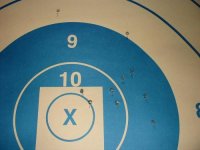Good barrel for bullet failure tests
Jeff sent a link to the video showing his "puffing" bullets. If further tests indicate that the bullets are actually failing when fired with normal loads through a fouled barrel then Jeff has a good barrel to test for bullet failures.
In Auguat of 2009 I posted a series of test results based on firing various bullet designs out of a good barrel with a clean and dry bore. The dry bore was employed to increase bullet to bore friction and to simulate an older barrel. The results are very interesting and can be found in the BRC archives by searching for user "HBC", checking the "Posts" button, which will bring up the title with 108 bullets with Retumbo. The series of posts are long and not well organized but there is no time to work on rewriting.
Among other results the tests indicate:
Bullet failure is more likely to occur on the first round out of a clean barrel with bore cleaner, oil, grease or conditioner remaining in the barrel.
Flat base bullets are much more likely to fail than a boat tail bullet of the same weight, same core and jacket, both made in the same dies.
Henry
BRIEF DESCRIPTION OF BULLET FAILURE TESTS
Tests conducted by firing gilding metal jacketed, lead core, hollow point, flat base bullets out of a clean and degreased bore (dry bore) resulted in somewhat surprising results. The rifle barrel was of high quality, good condition, 6 mm caliber and with a 10 inch rifling twist:
It was assumed that a dry bore would result in increased friction and thus simulate a bore roughened by the firing of many rounds in competition and thus result in more bullet failures to study.
Flat base bullets were chosen as the study projectiles because analysis indicated that higher friction would occur at the base of the bearing area of a flat base bullet than would occur at the base of the bearing area of a similarly designed boat tail bullet of the same caliber, jacket weight, core weight, bullet weight and the same ogive shape and ogive length. Bullet maximum acceleration at maximum chamber pressure, just beyond the barrel chamber, is on the order of 140,000 g's for 1000 yard BR loads with bullet acceleration at the barrel muzzle on the order of 15,000 g's, depending on load and barrel length. The bullet acceleration within the barrel induces pressure within the lead core thus forcing the jacket against the barrel bore. Greater core pressures would likely occur as the distance from the top of the core, in the ogive area, increased thus resulting in more bullet to bore friction and bullet heating at the base of the bullet bearing surface than at any other point on the bullet jacket (It can be argued that heat transfer from propellant gases through the base of the bullet is not the major source of bullet heating, if blow by of propellant gases past the bullet is not excessive. Results from tests not mentioned here provide some information on propellant gas blow by).
Test results for 116 grain and 121 grain flat base bullets fired at just below 3000 ft./sec. muzzle velocity resulted in 100% failure of bullets fired out of a dry bore. Bullet failure was indicated by molten lead spray impacting adjacent to the bullet hole in a paper screen placed 20 yards from the rifle muzzle. Each dry bore test was followed immediately by firing a second round identical to the first round through the fouled bore. None of the bullets fired out of a fouled bore failed (one might conclude that nitrocellulose fouling, which might include additives by the propellant manufacturer to reduce bore friction, is an excellent lubricant when compared to a dry bore and when compared, in other tests not described here, to lubricants, conditioners and cleaners used by shooters to clean rifle bores).
Further testing involved machining 3 degree boat tails of approximately 0.2 inch length in the jacket bearing area of the flat base bullets near the base of bullets where the test bullets were obtained from the same lot of bullets used in the dry bore tests described above. The bullets were fired out of a dry bore resulting in no failures of the modified bullets, modified with machined boat tails as described above. The machined boat tail bullet tests supports the conclusion, from previous analytical analysis, that higher bullet jacket bearing to bore friction with resulting higher bullet frictional heating occurs with higher core mass occurring within the bearing and ogive areas of the bullet. (Machining a boat tail in a bullet by removing jacket material near the base of the bullet might seem like a destructive modification to some shooters, however, analysis shows that stress in a bullet boat tail side wall, due to internal core pressure resulting from bullet acceleration and propellant gas pressure, is relatively low.) However the bottom of the bearing area of a flat base or boat tail receives significant frictional heating and in addition, receives heat flow into the bullet from the hot propellant gases.
Bullet failure, of course, is related to forces applied to the bullet including centrifugal force, stresses within the unsupported ogive jacket during maximum bullet acceleration and stresses in the bullet bearing jacket, unsupported by the barrel bore, as the bullet exits the muzzle. However it can be argued that bullet heating due to bore friction and heat transfer from propellant gases can, under certain normal conditions of barrel bores, result in sufficient jacket heating to weaken the jacket enough for normal forces to result in bullet failure.


